notised you are from arizona i only now of one Lester there and he is a top hall of fame shooter
Lester is my best friend. We go to shoots together. He is number 2 in hall of fame points. I tease him all the time with this line " between you and I, we have about 15 world records" (I have none!) Only Tony has more hall of fame points and he will never be caught - the current level of competition prevents that.
Gary O'cock is also a hall of fame shooter and gunsmith. When a big shoot comes along, he just grabs an old barrel, sets it back a bit and then goes out and wins. Gary and Lester are both amazing 200 yard shooters. Gary still holds the world record at 300 yards. .149 5 shot group. That is amazing because with a 36 power scope, you can hardly see the bullet hole. He told me that when he shot the group, he didn't know if the bullets were going into the same hole or if he completely missed the target.
-
Welcome back Guest! Did you know you can mentor other members here at H-M? If not, please check out our Relaunch of Hobby Machinist Mentoring Program!
You are using an out of date browser. It may not display this or other websites correctly.
You should upgrade or use an alternative browser.
You should upgrade or use an alternative browser.
why?
- Thread starter JT.
- Start date
winning the SS with gear you made yourself must give 10x more satifaction
i may not be a great shooter like the real pros but my 4th place years ago(for once everything feld good ) in the 200 HV and in the running to win the 200 LV (till i fel of the bench the last shot of the SS and ended 20 th ore so) with a barrel chambered by a friend ,i tought immidiatly "what a great barrel job ". made my own stocks and bullets ,home made frontrest the next logic step is doing my own chamber job .some time i am maniac on a thing and i can get in to it real deep and this is gooing that direction i will go for so close as i can get to perfection just to now i dit the best job i can do
You are correct about the satisfaction of building your own equipment - that is why I have the lathes and mills - it is an additction. I hate making bullets but don't trust anyone else to make them for me. It only takes one bad one to ruin your day. Bob Dodd (another arizona gunsmith - now retired from competitive shooting) built his own action (RFD), rest, press, etc. and won the supershoot. That was many years ago. I don't do the SS anymore. Too many shooters, too much of a rush to clear the benches between relays, too long to wait between relays, etc, etc. Even the nationals are slow going.
Earl,
My comment was not intended as a slight to competitive shooters. I compete in bench rest enough to know how many variables are involved in shooting a good target. It gives me tremendous respect for those who shoot in the ones consistently let alone in the zeros.
My comment does not relate to their ability to evaluate a barrel. It relates specifically to what a target can tell us about the quality of a chamber job. It would be a surprise for me to learn that someone can look at a target and end up saying ‘’ ah yes the chamber job is bad on this barrel’’. As you implied, when a new barrel doesn’t shoot to expectations there are several factors to consider. Isn’t that why we can say that a good chamber job is no guarantee that the gun will shoot? If a new barrel doesn’t shoot and gets put aside, isn’t the next barrel chambered in exactly the same way?
Cutting a chamber (and cutting a crown ) is a machining operation that can be done reliably and checked for precision before it leaves the shop. It can be done and done well by a machinist who understands the objective of the operation but who has never pulled a trigger.
Some top competitors who do their own smithing accomplish amazing results at the range. However, there is ample evidence that one can be a top gunsmith without being a competitor. If someone is passionate about learning to cut chambers properly, which I think is what this thread is about, it can be done without having to win the Super Shoot first.
With respect, Mike
You are correct in your statement about the chambers, I guess I should have stated that as a bad chamber job shows up quickly. I have done a few of those and they do show up quickly. I made a bad assumption that I could make a better fit on the threads. I cut the threads very close on the maximum diameter. I screwed the barrel on and it shot just "OK" When I went to take it off, it wouldn't budge. I had galled the threads. Had to remove the action (it was glued in), cut the barrel off close to the action, and bore the barrel out. Took me all day. I have also used too small of a pilot bushing and and had the reamer wobble and create an oversized chamber. (leads to case head separation after only a few resizes of the case)
There are indeed many good gunsmiths that are not shooters. There are also quite a few benchrest shooters that started out as gunsmiths. (Greg from Kelbly's is one of them)
Earl,
I appreciate your sharing your experiences with us. When you used a too small bushing on the reamer, can you give us an idea of how much too small? Fitting the right bushing was a step I found a bit tricky for a newbie.
May we also know how the reamer was held and pushed in that case? I'm here to learn and believe that there is a lot to learn.
Thanks, Mike
I appreciate your sharing your experiences with us. When you used a too small bushing on the reamer, can you give us an idea of how much too small? Fitting the right bushing was a step I found a bit tricky for a newbie.
May we also know how the reamer was held and pushed in that case? I'm here to learn and believe that there is a lot to learn.
Thanks, Mike
- Joined
- Nov 20, 2014
- Messages
- 9
There are a lot of ways to chamber a rifle barrel. All of them can work if the geometry of the barrel blank happens to match the method chosen. Only one works, in theory, pretty much regardless of barrel blank geometry. That's the one in the Grizzly video. It aligns the breech threads, shoulder, and chamber, with the segment of the bore that is the lands and immediately after the lands. Done correctly, that assures those elements are aligned. Other methods can result in them being aligned, or possibly not misaligned enough to matter, but in general they aren't theoretically as correct.
I have used a slightly modified version of the Grizzly video method including pre-bore on a number of rifles and they all shoot tiny little groups. Other folks have used different methods, including the zero both ends method with the breech clamped directly in the chuck jaws, and had barrels that shoot tiny little groups. The chuck jaws turn the centering of the far end into a barrel bending exercise.
I use a ring of #6 or #10 copper ground wire around the breech to hold it in the 4J. Same on the other end where the cross head screws will contact it unless I tape the barrel first.
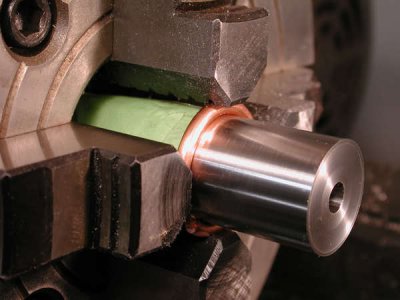
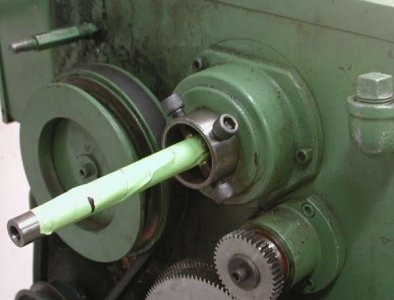
This is my through the headstock chambering setup:
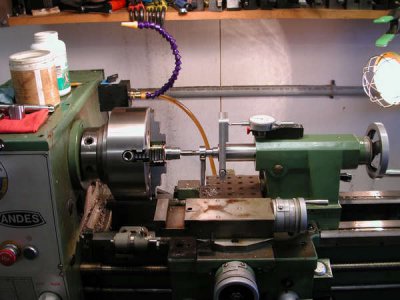
Note the dial indicator on the tail stock for measuring depth.
This is my home made reamer pusher:
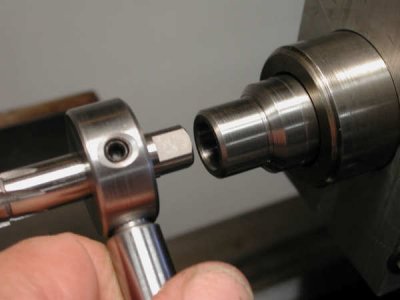
If anyone is interested I can explain the theory behind the design and how it was made.
The hardest barrel I've done was for my wife's sporterized 1903 Springfield. Her father had the rifle built for her in the fifties. The bore was destroyed when someone fired surplus ammo with corrosive primers. It was a challenge. Square threads right to the barrel shoulder weren't too bad. The hard part was figuring out how to perfectly align the extractor groove in the end of the barrel so it fit perfectly when the barrel was torqued in place. Once I figured that out and found the nominal dimensions it came out really well. This shows the setup for cutting the extractor groove. I torqued the barrel with the completed chamber into the receiver, held the barrel in my home made barrel vise, indicated it until the bottom of the receiver was parallel with the mill table, tightened the vise, removed the receiver, and milled the slot. When I torqued the receiver back into place and reinstalled the extractor on the bolt, it all fit (and I resumed breathing). This is the setup for cutting the extractor slot in the breech of the barrel:
Setup:
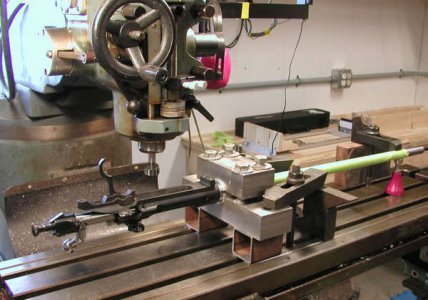
Cut done (it had to be done upside down to avoid a climb cut which would have been a disaster):
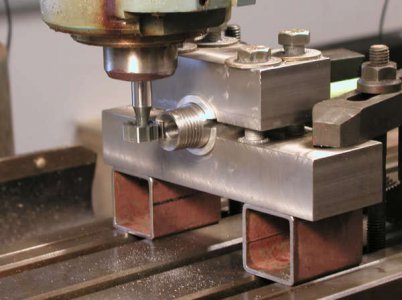
It fits:
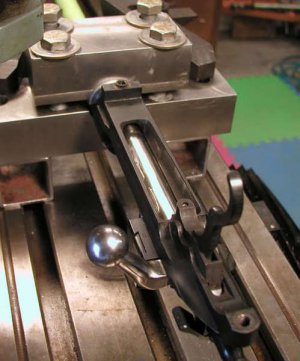
Fitch
I have used a slightly modified version of the Grizzly video method including pre-bore on a number of rifles and they all shoot tiny little groups. Other folks have used different methods, including the zero both ends method with the breech clamped directly in the chuck jaws, and had barrels that shoot tiny little groups. The chuck jaws turn the centering of the far end into a barrel bending exercise.
I use a ring of #6 or #10 copper ground wire around the breech to hold it in the 4J. Same on the other end where the cross head screws will contact it unless I tape the barrel first.


This is my through the headstock chambering setup:

Note the dial indicator on the tail stock for measuring depth.
This is my home made reamer pusher:

If anyone is interested I can explain the theory behind the design and how it was made.
The hardest barrel I've done was for my wife's sporterized 1903 Springfield. Her father had the rifle built for her in the fifties. The bore was destroyed when someone fired surplus ammo with corrosive primers. It was a challenge. Square threads right to the barrel shoulder weren't too bad. The hard part was figuring out how to perfectly align the extractor groove in the end of the barrel so it fit perfectly when the barrel was torqued in place. Once I figured that out and found the nominal dimensions it came out really well. This shows the setup for cutting the extractor groove. I torqued the barrel with the completed chamber into the receiver, held the barrel in my home made barrel vise, indicated it until the bottom of the receiver was parallel with the mill table, tightened the vise, removed the receiver, and milled the slot. When I torqued the receiver back into place and reinstalled the extractor on the bolt, it all fit (and I resumed breathing). This is the setup for cutting the extractor slot in the breech of the barrel:
Setup:

Cut done (it had to be done upside down to avoid a climb cut which would have been a disaster):

It fits:

Fitch
- Joined
- Nov 20, 2014
- Messages
- 9
I'll put the picture in again so I can talk about it.
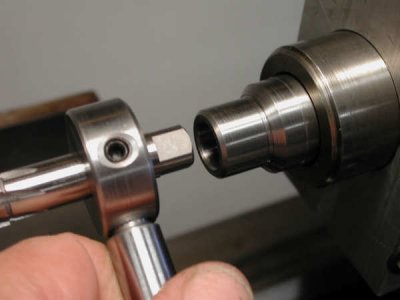
The setup uses the tail stock spindle to push the reamer, cut progress is measured by a dial indicator. The tail stock is up against the carriage so it can be returned to the same location after the reamer is removed for cleaning between cuts.
The pusher consists of two parts. The first is the piece in the tail stock. I turned an MT3 taper on a piece of round to fit the tail stock. Then I stuck it in the spindle in an MT5 to MT3 adaptor and machined the face of it to be perfectly orthogonal to the lathe spindle centerline. Then I drilled and finish bored a hole in it that is about .060 bigger than the reamer diameter and deep enough that the reamer won't touch the bottom of it when it's in the collar. I want the pusher to contact only the collar, not the reamer.
The push face of the collar was machined and the hole in it drilled and then bored to 'just' slide onto the reamer body. That means the push face is orthogonal to the reamer. I parted it off and faced the other side for appearance reasons. The collar has a short handle attached to it and a setscrew that tightens onto a flat on the reamer. The collar is installed on the reamer so the push face is toward the pusher/tail stock when the setscrew is up.
In use I hold the handle with my fingers with my thumb on the set screw. Done properly that creates a force couple that resists the reamer torque but doesn't exert any sideways force on the reamer. The piece in the tail stock pushes on it in such a way that if the reamer tries to get out of line, it is acted on to return to inline. The tube face of the pusher is like pushing on the collar with two fingers. It tends to stay straight. The limited radial movement is more than enough to accommodate misalignment. I can control the torque on the reamer with the tail stock feed wheel.
I take cuts of about 0.050" at first, tapering off to as little as 0.010" as I approach the final depth. I feed with my right hand on the tail stock feed wheel. I stop when the first chips appear in the reamer flute after the reamer is past the shoulder of the reamer. The procedure for stopping is to let go of the reamer and reverse the tail stock feed wheel direction at the same time. Turn the spindle motor off after the tail stock is backed off to the point it won't engage the reamer after it's cleaned and reinserted. That leaves the reamer turning with the barrel blank until the spindle stops. When it's stopped I slide the tail stock back to obtain clearance and pull the reamer straight out. This eliminates the chance of swarf getting trapped under a flute to be dragged and cause galling damage in the chamber.
I remove the reamer, clean it by dipping it in paint thinner and blowing the chips off it. I dip it in cutting oil, reinsert it, bring the tail stock forward, gently engage the reamer and take the next cut.
The reamer with a bushing pilot starts very nicely in the pre-bored barrel blank. So far (a half dozen chambers - I only do my own rifles) the scheme has worked well.
Fitch

The setup uses the tail stock spindle to push the reamer, cut progress is measured by a dial indicator. The tail stock is up against the carriage so it can be returned to the same location after the reamer is removed for cleaning between cuts.
The pusher consists of two parts. The first is the piece in the tail stock. I turned an MT3 taper on a piece of round to fit the tail stock. Then I stuck it in the spindle in an MT5 to MT3 adaptor and machined the face of it to be perfectly orthogonal to the lathe spindle centerline. Then I drilled and finish bored a hole in it that is about .060 bigger than the reamer diameter and deep enough that the reamer won't touch the bottom of it when it's in the collar. I want the pusher to contact only the collar, not the reamer.
The push face of the collar was machined and the hole in it drilled and then bored to 'just' slide onto the reamer body. That means the push face is orthogonal to the reamer. I parted it off and faced the other side for appearance reasons. The collar has a short handle attached to it and a setscrew that tightens onto a flat on the reamer. The collar is installed on the reamer so the push face is toward the pusher/tail stock when the setscrew is up.
In use I hold the handle with my fingers with my thumb on the set screw. Done properly that creates a force couple that resists the reamer torque but doesn't exert any sideways force on the reamer. The piece in the tail stock pushes on it in such a way that if the reamer tries to get out of line, it is acted on to return to inline. The tube face of the pusher is like pushing on the collar with two fingers. It tends to stay straight. The limited radial movement is more than enough to accommodate misalignment. I can control the torque on the reamer with the tail stock feed wheel.
I take cuts of about 0.050" at first, tapering off to as little as 0.010" as I approach the final depth. I feed with my right hand on the tail stock feed wheel. I stop when the first chips appear in the reamer flute after the reamer is past the shoulder of the reamer. The procedure for stopping is to let go of the reamer and reverse the tail stock feed wheel direction at the same time. Turn the spindle motor off after the tail stock is backed off to the point it won't engage the reamer after it's cleaned and reinserted. That leaves the reamer turning with the barrel blank until the spindle stops. When it's stopped I slide the tail stock back to obtain clearance and pull the reamer straight out. This eliminates the chance of swarf getting trapped under a flute to be dragged and cause galling damage in the chamber.
I remove the reamer, clean it by dipping it in paint thinner and blowing the chips off it. I dip it in cutting oil, reinsert it, bring the tail stock forward, gently engage the reamer and take the next cut.
The reamer with a bushing pilot starts very nicely in the pre-bored barrel blank. So far (a half dozen chambers - I only do my own rifles) the scheme has worked well.
Fitch
- Joined
- Nov 20, 2014
- Messages
- 9
Just too cool. I am going to grab 2 of your photos if I may and the write-up above. I want to try this on my next chambering job. Let me know if you are okay with this please.
Thanks,
Go for it. Let me know how it works for you.
Feed gently. You will find you can control the torque very precisely and keep it uniform with the tailstock hand wheel.
Fitch

